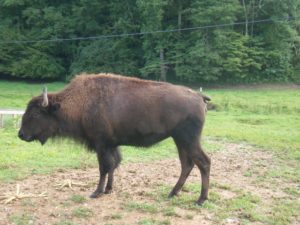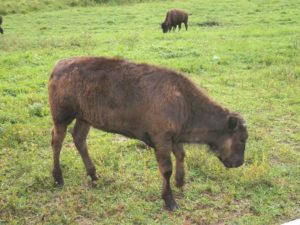August 14, 2017
Buckhorn Neighbors: The Brown Farm and Its Bison Herd
I first became fascinated by bison when, as a child, I read Robert McClung’s 1960 book Shag, Last of the Plains Buffalo. The story of the magnificent beast’s struggle against drought, famine, and hunters made a lasting impact on me. Imagine my delight to realize that a herd resides only a little more than a mile from the Buckhorn Inn!
Locals know Benny Hammonds as the longtime Gatlinburg-Pittman high school football coach. In 2013 he purchased 3 bison cows and one bull. A recent birth puts the size of the herd at seven now. To visit The Brown Farm, turn right onto Buckhorn Road from Tudor Mountain Road. Drive a little more than a mile (the road turns into #454) and you will see the farm on the left. There is no admission charge and there is parking. Be careful–the fence is electrified.
Status of American Bison
The American Bison (also sometimes called American Buffalo) is the largest surviving land animal in North America. During the 19th and 20th centuries the creatures were hunted nearly to extinction. An estimated 50 million bison were slaughtered for sport. They are no longer listed as endangered, but their future is not assured. According to the National Bison Association, http://www.bisoncentral.com, it is mainly through the efforts of small farmers, like Mr. Hammonds, that the animals are being preserved.
They may appear peaceful and nonchalant, but bison can charge without warning. Both males and females have horns and can use their massive heads as battering rams. They can gallop at speeds near 35 mph and typically weigh around 2,000 pounds, so you can imagine the momentum they can establish.
They are herbivores and prefer to eat grass and sometimes sedges. Early mornings and evenings are often the best times to see them be active. They rest during the day and graze during the morning and evening hours.
They like to roll in depressions in the dirt–a behavior called “wallowing”. Wallowing may help them cope with biting insects and to self-regulate their body temperatures.
We hope you get a chance to visit these magnificent creatures.






Gatlinburg Weather
Click for weather forecast